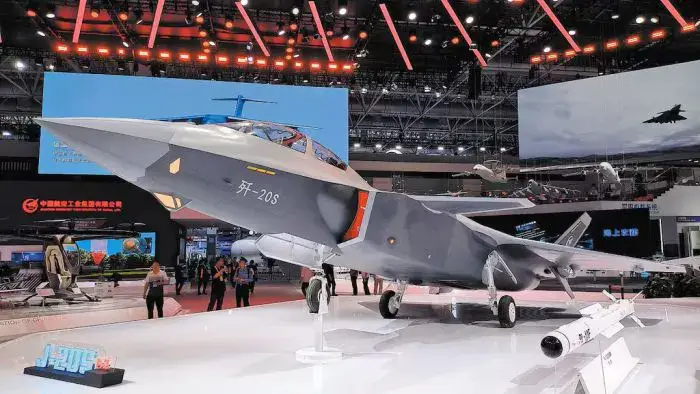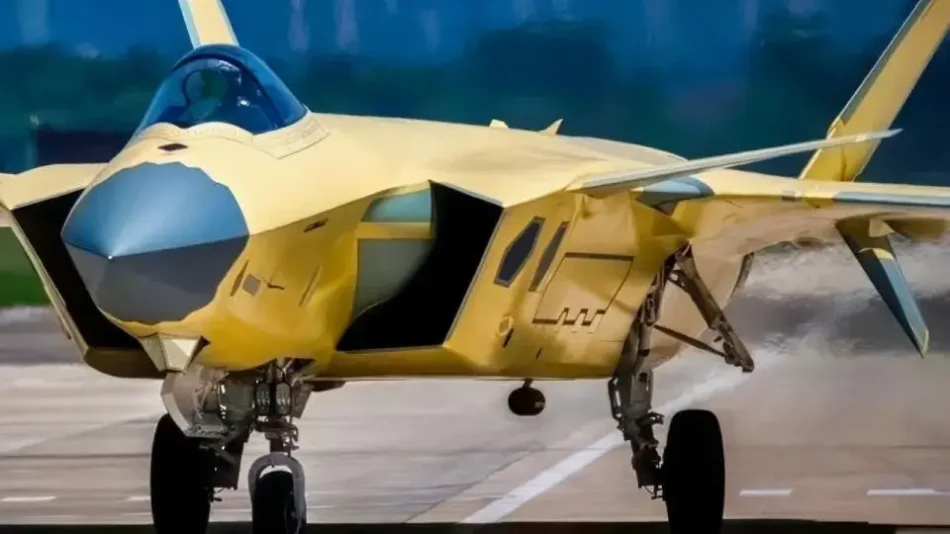The J-20 “Mighty Dragon” is China’s primary advanced stealth fighter, built for air superiority and precision strikes, featuring radar-evasive design, long-range missiles, and cutting-edge avionics for modern aerial dominance.
The J-35 is China’s carrier-based stealth fighter, designed for the PLA Navy. It features folding wings, electromagnetic catapult compatibility, and advanced stealth shaping for air superiority and strike missions. Optimized for naval operations, it rivals the US’s F-35C, extending China’s power projection at sea.
Looking at the differences between these two stealth fighters, the J-35 is a carrier-based, medium-weight stealth fighter for naval operations, while the J-20 is a larger, land-based air superiority stealth fighter with longer range and heavier payload.
The J-35 gives China a carrier-based stealth fighter for the first time, matching the US’s F-35B’s role and extending Beijing’s naval strike reach beyond US bases in Asia, a clear threat to US military dominance.
The J-20 meanwhile competes with the US F-22 with longer-range missiles (PL-21), advanced stealth shaping, and super cruise capability. Its larger size allows more fuel and sensors, while its data-linked swarming tactics challenge the F-22’s dominance in air superiority and standoff strikes.
J-35A is the land-based version of the J-35, similar in size and role to the US F-35. It’s designed for multirole missions (air-to-air and air-to-ground), with two engines, advanced sensor fusion, and agility. It complements the heavier J-20 as a more affordable, mass-producible fighter.
China has rapidly modernized its navy and air force over recent years, developing aircraft carriers, advanced destroyers, and long-range missiles to challenge US dominance in the Pacific.
Wang Yongqing, chief designer at the Aviation Industry Corporation of China’s Shenyang Aircraft Design and Research Institute, commented:
“Many of our research achievements can be applied across different variants, such as sensors, onboard equipment, and avionics systems. This development model has significantly reduced both the costs and time required for fighter jet development.”

These Chinese aircraft are a serious challenge to the US for a few reasons, but one is because of their swarm tactic integration with drones.
Even with this jump in advancement for their jets, China is already working on another 5th generation stealth jet, dubbed the J-50, with details obviously being top secret.
Drones have become a main component of military exercises in the current era of modern warfare, and China is looking to take the lead in this technology. The usage of drones in the Ukraine war has clearly changed how war is fought, and China is adapting quickly to this new paradigm.
Both the J-20 and J-35 are integrated with loyal wingman drones (like the GJ-11) for swarm tactics. These drones extend sensor range, act as decoys, or launch missiles, overwhelming enemy defences. China’s networked, AI-driven swarms allow its stealth fighters to operate as command nodes, coordinating drone attacks while staying beyond adversary engagement ranges.
The US has similar concepts (e.g., Collaborative Combat Aircraft) but lags in large-scale deployment. China’s rapid testing and fielding of drone swarms, backed by state-driven AI and 5G, give it a tactical edge for now.
Commenters have been discussing these jets and the comparison to the US counterparts over the last few years, with many US commenters complaining that their jets have been copied and improved upon:
“An aesthetically beautiful plane, compared to the F-35 for sure.”
“Well, my opinion is that we need more info on the J-35s capabilities. And in war time, the F-35 is just far too maintenance heavy to be a truly effective war machine. It needs so much maintenance and it’s controlled too tightly to be able to be let loose and show its true potential. The F-35 was never about being the best fighter in the world, it’s about squeezing every penny possible from the US and allied governments.”
“The Chinese are smart, they let their buddy spend most of their money on R&D and let one spy to get in and take all the data. Pretty smart of China to let the USA spend 100 billion dollars on researching while they spend much less on R&D.”
“By what we can observe on the aerodynamics side, the J-35 is obviously much better in achieving higher speed and stealth.”
“First Gen5 to be carrier launched by EMAL system. I think there’s no denying China is very hungry to beat everyone in the technology domain.”
Other commenters stress how China might have started to catch up in technology, but aren’t anywhere close to the same experience as US pilots, and that the J-20 and J-35 might be impressive on paper, but they haven’t truly been tested in real war scenarios yet.
Whether this is true or not remains to be seen. In a way, it’s a hope that the Chinese jets never get directly tested against their US counterparts, because such a war would be devastating to the world. But considering that China is poised to sell more of these jets to other countries, it might just be a matter of time before we see them compete in a proxy war somewhere.








